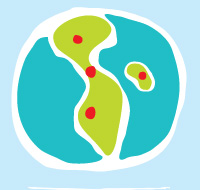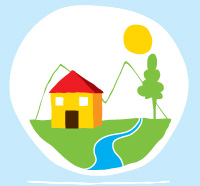
Resilience in science and technology are key topics, particularly when we want to address the issue of Climate Change adaptation (CCA).
Resilience in the ecology of communities and ecosystems
The capacity of resilience of an ecosystem is directly related with the richness of species and the transference of ecological functions that this has. In other words, the system in which its integrants have more diversity and number of ecological functions will be able to face a specific disturbance in a better way.
Ecologic Resilience
In ecology of communities and ecosystems, the term resilience indicates their capacity of absorbing disturbances, without significantly altering its characteristics of structure and functionality, meaning, they would be able to go back to its original state once the disturbance has ended. In that sense, we can observe that communities with more complex ecosystems (that have a vast number of interactions among its parts), have usually major resiliencies for there are a bigger quantity of self regulation mechanisms.
The capacity of resilience of an ecosystem is directly related with the richness of species and the superposition of ecological functions that these have. Meaning that a system in which its integrants have more diversity and number of ecological functions will be able to face in a better way a specific disturbance.
Resilience is defined as the capacity of a system to return to the previous conditions to the disruption (Fox and Fox, 1986; Pimm, 1984; Keeley, 1986). To calculate it in a determinate time period one calculates the quotient between the measures before and after the disturbance of any descriptive variable of the ecosystem (Tilman and Downing, 1994).
Source: Wikipedia http://en.wikipedia.org/wiki/Resilience_%28ecology%29
Adaptability, vulnerability and resilience in complex social- ecological systems: sustainability depends upon… the dynamic quality of maintaining adaptable capacity and opportunities… [Because] the real world is full of surprises or disturbances and long term structural transformations… New instruments and concepts are necessary to understand complex adaptable systems transitions. A concrete example of that is Climate Change Adaptation. These highlight the importance of disturbance, diversity, and novelty in the determination of resilience, and thus sustainability of ecosystems and its joint human enterprises. "Such knowledge has to be directed to the fixation of particular social- economical systems- and their adaptable capacity- within bigger regional and global contexts”. This topic has also being identified as deserving the highest priority in a separate report of the ICSU rainbow series, using the extended work of the Resilience Alliance.
Environment Resilience
It is the measure of the ability or capacity that an ecosystem has to absorb environmental stress without changing its characteristic ecological patterns, this implies the system’s capacity to reorganize itself under environmental tensions and to establish alternative energy flows to remain stable without severe perturbations, only with some minor modifications into its structure; thus, resilience illustrates the capacity of natural systems to recover from the adverse effect produced by the action of minor nature itself.
Health Resilience
It is a Medical study of anything related to stress in therapeutic processes, and in general, in the techniques used to face adversities.
Resilience in Biology
It is defined as the capacity of rapidly recover from a disease or a natural disaster. Resilient creatures can live well in harsh situations in accordance to their adaptation to the ecosystem and the changes that happen in it.
Human capital is a term used in certain economical theories of growth to designate a hypothetic factor of production which depends not only in quantity, but also of quality and degree of formation and productivity of the involved persons in a productive process.
From that initial technical use, it has spread to designate the collection of human resources that an economical enterprise or institution possesses. Likewise one can talk about an informal manner of improvement in the human asset when the skills, experience, or formation degree of people in the afore mentioned enterprises or institutions increases.
In the educational institutions it is designated as “the set of knowledge, abilities, skills and talents that a person possesses and makes him/ her able to develop specific activities”.
This Theory is based upon a double interpretation and foundation. The first of an economics character: productivity of the worker is in function of the received education. The more specialization (by means of the formal educative system), via work (non formal), increases the productivity and it is compensated by the highest salaries. The second of an assignations’ character: education has essentially a functions of «assignation». School grades provide criteria of «selection of staff» to businessmen. Education has «non –cognitive» effects: it influences in the attitude and behavior of workers.
Source: Wikipedia
Fuente: Wikipedia http://en.wikipedia.org/wiki/Human_capital
There are three types of social-political resilience: social sciences: in anthropology, and in sociology
Resilience in Social Sciences
It is the capability of an individual to be able to live well and to positively develop, in spite of the hard living conditions. The subject has to come out strengthened and transformed by his bad experiences, each tome stronger, with a positive attitude.
Resilience in Sociology
It is the social development of a person and its adaptation within a given environment. It is to resist, to overcome and see himself / herself transformed by a risk situation. The capability of being resilient can be developed through the formation of a socially competent person who has the capability of having his/ her own and useful identity. He/ she can adapt and develop resilience to customs, language, and living manners of the visiting country.
Resilience in anthropology
Resilience can be presented with the example of human evolution. Through time, since the Australopithecus to the Homo sapiens, they have performed adjustments to their social, hunting, organization and mental methods.
The capacity of resistance is tried in situations of strong and prolonged stress, for instance due to the unexpected loss of a beloved person, psychological abuse or physical mistreat, affective abandon, failure, natural catastrophes and extreme poverty.
Resilience is the capability that an individual possesses before adversity, to stand up and fight, with a dose of perseverance, tenacity, positive attitude and actions that allow him/her to advance against the flow and overcome those.
E. Chávez and E. Yturralde (2006)
Resilience is a dynamic process that has as a result the positive adaptation in contexts of great adversity.
Luthar (2000)
Resilience distinguishes two compounds: resistance to face destruction, meaning the capability the own integrity, under pressure and, on the other hand, beyond resistance, the capability to forge a vital positive behaviour in spite of difficult circumstances.
Vanistendael (1994)
Resilience has characterized as a group of social and intra psychic processes that allows having a «healthy» life in an unhealthy environment. These processes are done through time, providing fortunate combinations amongst the child’s attributes and his/her familiar, social and cultural environment.
Rutter (1992)
Ability to re-emerge from adversity, to adapt, to recover and to Access to a significant and productive life.
ICCB, Institute on Child Resilience and Family (1994)
The art of overcoming adversities with our feet rooted on mother earth.
Jorge Montoya Avecías (2006)
Generic concept referred to a wide gamma of risk factors and their relationship with the results of the competence. It can be product of a conjunction between environmental factors and the temperament, and a type of cognitive ability that some children have even when they are so little.
Osborn (1996)
Capability of the human being to face adversities, overcome them, and even be transformed by them.
Grotberg (1995)
Resilience means a combination of factors that allow a child, a human being, to face and overcome the problems and adversities of life, and build upon them.
Suárez Ojeda (1995)
Resilience is a global response in which protection mechanisms are at stake, understanding that these are not the contrary value to risk factors, but that dynamic that allows the individual to come out strengthened form the adversity, in each specific situation and respecting the personal characteristics.
Infante (1997)
Source of this page: Wikipedia

Resilience in Situations of Chronic Violence
For adolescents, youth and adults, community or NGO leaders
Request module
Crosscutting Themes Module
Gender, Child Protection, Disabilities, HIV/AIDS/Health and Environment
Request module
Formal Education & DRR
Guidelines to address DRR issues in the context of formal education
Request module




















